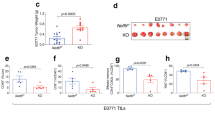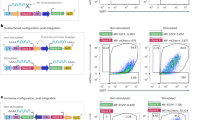Abstract
Initiation of T-lymphocyte proliferation by mitogen or antigen involves a cascade of gene activation events. Thus, by the time mitogen-activated T cells have reached the G1/S interface, many genes that are transcriptionally silent in GO, like the c-myc, IL-2, IL-2 receptor (IL-2R) and transferrin receptor (TfR) genes, have been transcriptionally activated1–4. To understand the role of the individual genes in the activation process, one must be able to interfere specifically with the expression or function of each particular gene product. In this way, by blocking the IL-2R with an antibody, it has been demonstrated that IL-2/IL-2R interaction is required to induce TfR expression in activated T cells3. When the function or expression of intracellular proteins is to be blocked, however, the need to introduce antibodies into the cytoplasm of viable cells, although possible5–7, is a limiting factor. We have taken another approach, namely the exogenous addition to bulk cell cultures of small antisense oligomers. Sequence-specific anti-sense oligodeoxyribonucleotides have been reported to inhibit intracellular viral replication without interfering with cellular protein synthesis8,9. Similarly, rabbit globin mRNA translation in a cell-free system and in rabbit reticulocytes has been inhibited by oligomers complementary to the globin mRNA initiation codon region10. Recently, a pentadecadeoxyribonucleotide complementary to the initiation codon and four downstream codons of human c-myc mRNA was reported to inhibit the proliferation of the human leukaemic cell line HL-60 specifically11. We report here that the same c-myc complementary oligonuelectide inhibits mitogen-induced c-myc protein expression in human T lymphocytes and prevents S phase entry. Interestingly, c-myc antisense treatment did not inhibit G0 to G1 traversal as assessed by morphologic blast transformation, transcriptional activation of the IL-2R and TfR genes, or induction of 3H-uridine incorporation.
This is a preview of subscription content, access via your institution
Access options
Subscribe to this journal
Receive 51 print issues and online access
$199.00 per year
only $3.90 per issue
Buy this article
- Purchase on SpringerLink
- Instant access to full article PDF
Prices may be subject to local taxes which are calculated during checkout
Similar content being viewed by others
Author information
Authors and Affiliations
Rights and permissions
About this article
Cite this article
Heikkila, R., Schwab, G., Wickstrom, E. et al. A c-myc antisense oligodeoxynucleotide inhibits entry into S phase but not progress from G0 to G1. Nature 328, 445–449 (1987). https://doi.org/10.1038/328445a0
Received:
Accepted:
Issue Date:
DOI: https://doi.org/10.1038/328445a0
This article is cited by
-
MYC: a multipurpose oncogene with prognostic and therapeutic implications in blood malignancies
Journal of Hematology & Oncology (2021)
-
Selective targeting of MYC mRNA by stabilized antisense oligonucleotides
Oncogene (2021)
-
Regulation of survival, proliferation, invasion, angiogenesis, and metastasis of tumor cells through modulation of inflammatory pathways by nutraceuticals
Cancer and Metastasis Reviews (2010)
-
RNA interference-mediated c-MYC inhibition prevents cell growth and decreases sensitivity to radio- and chemotherapy in childhood medulloblastoma cells
BMC Cancer (2009)
-
The estrogen and c-Myc target gene HSPC111 is over-expressed in breast cancer and associated with poor patient outcome
Breast Cancer Research (2008)



